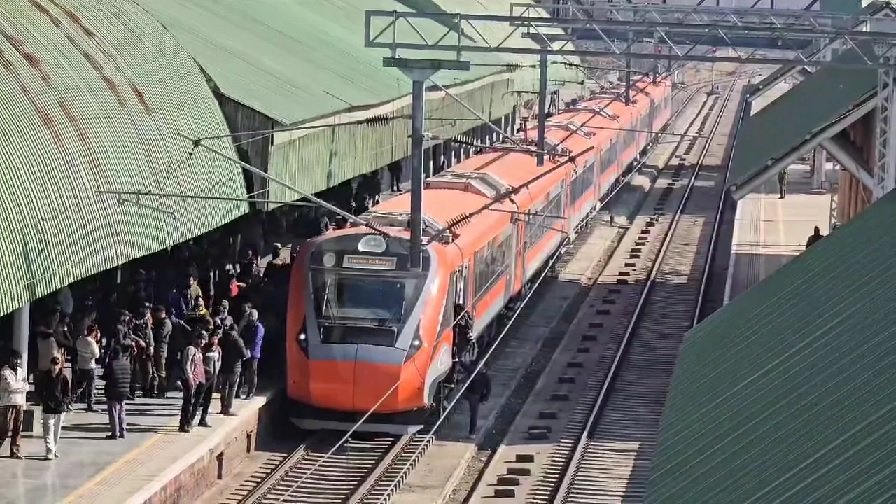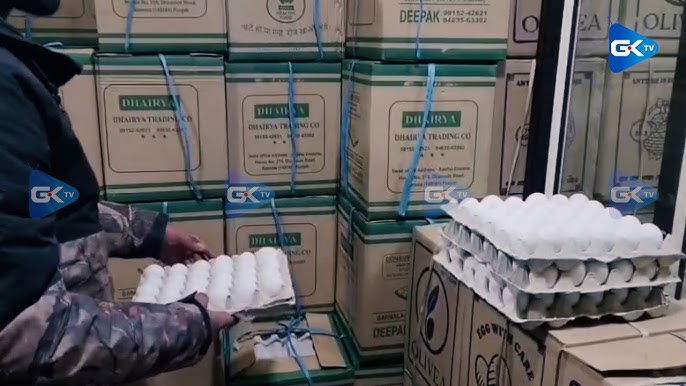Jammu Railway Division Readies for Festive Rush with Enhanced Passenger Services
By: Javid Amin | 14 October 2025
As the festive season dawns upon Jammu & Kashmir, the region’s railway network faces a yearly test of resilience, coordination, and service delivery. This year, in anticipation of a heavy surge in travelers — from pilgrims bound for Mata Vaishno Devi to families visiting the Valley — the Jammu Railway Division has rolled out a series of special measures and infrastructure upgrades to ensure smoother, safer, and more comfortable journeys across key routes.
These enhancements come against the backdrop of recent infrastructure disruptions caused by heavy rains and floods, as well as the historic commissioning of the Udhampur–Srinagar–Baramulla (USBRL) rail link. The stakes are high: reliable rail connectivity is vital not only for daily commuters, but for sustaining pilgrimage flows, tourism, and local economies. In the following sections, we unpack what the railways have introduced, how these changes address past challenges, and what travelers should know to make the most of them.
From Disruptions to Revival
Floods, Rain, and Restorations
In the weeks leading up to the festive period, the Jammu division’s rail services had been heavily impacted by unseasonal downpours, waterlogging, and infrastructure damage. Several long-distance trains were suspended, low-lying track segments declared unsafe, and operations curtailed in phases.
In response, the Northern Railway initiated a phased resumption of services. Notably, 16 trains — eight pairs — were reinstated from October 2 to October 8 to reconnect vital routes. News on Air+2Kashmir Life+2 Prior resumption had already seen eight more trains come back under “Fourth Phase” after repairs and safety checks.
However, continuing rains forced delays in the planned “Phase Five” rollouts. Trains such as Jammu Tawi–New Delhi and Jammu Tawi–Pune had their resumption postponed to mid-October. Officials cited ongoing track repair and bridge work as reasons.
This tug-of-war between restoration plans and climate unpredictability sets the stage for the railway’s proactive festival season measures.
A New Rail Era: USBRL and Strategic Upgrades
Parallel to damage control, the railways are riding a wave of transformative upgrades in Jammu & Kashmir. The USBRL project — linking Udhampur, Srinagar, and Baramulla — was inaugurated in June 2025, effectively stitching Kashmir to India’s broader rail network. This accomplishment follows decades of planning, engineering challenges, and terrain hazards.
As part of this greater push, the Indian Railways is also deploying modern track-maintenance machinery (tamping machines, ballast cleaning machines), automated defect detection systems, AI-based inspections, and upgrades to coach overhauls in the Valley region. DD News These efforts aim to not only restore but future-proof connectivity in the face of extreme weather and rugged terrain.
Together — restoration, modernization, and service enhancements — form the backbone of this year’s festive preparedness.
Key Enhancements for Festival Travel
The Jammu Railway Division’s strategy centers on three interlinked pillars: passenger convenience, information and communication, and security / operational resilience. Below is an overview of the main interventions and how they address real traveler pain points.
1. Help Desks & Physical Support Facilities
-
Help desks have been established at major junctions and high-traffic stations — Jammu, Pathankot Cantt, Pathankot City, Shri Mata Vaishno Devi Katra, and Srinagar — to assist with queries, ticketing hiccups, last-minute changes, and traveler navigation.
-
Temporary holding areas / waiting zones: In congested stations, dedicated holding zones are being used to regulate passenger flow. These areas are equipped with essentials like drinking water, ventilation/fans, toilets, and seating arrangements.
-
Restoration of station infrastructure: For example, at Jammu station, a new foot overbridge (FOB) connecting platforms 1 through 7 is nearing completion, with ~70% work done. Two of the platforms will be fitted with lifts, and signage is being designed in English, Urdu, and Dogri to aid accessibility.
These ground-level amenities aim to reduce station bottlenecks and provide comfort during long waits and transfers.
2. Real-Time Communication & Passenger Updates
-
Continuous train announcements are active at the major stations listed earlier, keeping travelers informed of arrivals, departures, platform changes, delays, and cancellations in real time.
-
Rail Madad grievance-redressal (Rail Madad 139) is being strengthened in staffing and responsiveness to resolve passenger complaints more swiftly.
-
24×7 surveillance rooms and monitoring centers: The division has set up central surveillance operations to monitor key stations, entry/exit gates, crowd buildups, and security threats around the clock.
-
Security augmentation: Additional personnel from the Railway Protection Force (RPF) and Government Railway Police (GRP) have been deployed, with increased vigilance at entry points, platforms, and inter-zonal transfer zones.
The intent is clear: to keep passengers better informed, to defuse congestion via early alerts, and to ensure coordinated response under pressure.
3. Operational & Safety Measures
-
Enhanced train punctuality focus: Officials have emphasized that festival-related disruptions must not become an excuse for delays. The division is pushing coordination between operations, signal, engineering, and rolling stock teams to maintain schedule integrity.
-
Phase-wise service reinstatement monitoring: Trains being reinstated in phases are allowed to resume only after safety clearance, structural inspections, track tests, and bridge assessments.
-
Disaster readiness and responsiveness: Given the history of landslides, flash floods, or track slips, an emergency-response posture has been maintained. The surveillance systems, help desks, and staff coordination are positioned to act swiftly.
-
Infrastructure resilience upgrades: The earlier track maintenance investments — including ballast cleaning, tamping, predictive defect detection, and automated monitoring — are critical for keeping the rails safe under heightened seasonal stress.
Together, these measures aim to define a more reliable, safer, and passenger-centric railway experience during what is often the most demanding travel window of the year.
Traveler Benefits & Strategic Impacts
Enhanced Pilgrim & Tourist Ease
Vaishno Devi pilgrims, a constant stream during festival time, stand to benefit from more assured train connectivity, clearer announcements, and support desks at Katra. The ability to reach closer to pilgrimage hubs and transfer with less friction helps reduce dependence on overcrowded road services.
Tourism in the Kashmir Valley, too, gains momentum—restored services and clearer advisories reduce the risk premium travelers factor in, making travel more predictable. This is especially relevant in a region where road access is highly sensitive to weather disruptions.
Comfort, Safety & Confidence
For regular and first-time travelers alike, the presence of help desks, real-time updates, surveillance, and augmented security offers psychological reassurance. Knowing that delays will be communicated, staff will be available to assist, and protocols exist for emergencies helps reduce stress during long transfers or crowded stations.
Resilience & Trust Building
Every successful festival season with minimal glitches builds public confidence in the railways. Given the recent disruptions, successes now help reset perceptions: that the railways can bounce back, adapt to disruptions, and deliver under pressure.
By combining rapid restoration with strategic upgrades and customer-facing measures, the railways are aligning operational reliability with passenger experience.
Risks, Challenges & Areas to Watch
No system is perfect, especially under as complex a mandate as running trains through Himalayan terrain during monsoon season. Below are key vulnerabilities and recommendations.
Unpredictable Weather & Topography
Persistent rainfall or sudden weather events could hamper track integrity, cause landslides or slope failures, or flood low-lying sections. Even well-maintained tracks may be vulnerable under heavy deluge, forcing re-suspension of services. Devdiscourse+1
Recommendation: The railway must maintain contingency protocols with real-time weather interception, scheduled stoppages before high-risk zones, and fallback bus-train interlinks.
Overcrowding & Passenger Overflows
Stations like Jammu, Katra, Srinagar may still face surges beyond holding capacity, especially if trains are delayed or platforms misaligned. Help desks can assist but only to a point.
Recommendation: Expand modular waiting areas (e.g. tents, mobile shelters), queue management barriers, and mobile announcement systems to manage overflow.
Communication Gaps & Last-Mile Mismatch
Some passengers may not receive instant updates (mobile network dead zones, app lag, language barriers). Also, mismatches between platform changes and available shuttles or footbridge capacity could cause stranding.
Recommendation: Use multiple redundant channels (PA systems, trainside screens, staff on ground, mobile SMS/WhatsApp alerts) and ensure footbridge capacity and shuttles adapt dynamically based on crowds.
Infrastructure Repair Lag
Phase Five resumption delays expose that major bridge or track repairs may lag despite best efforts. Post-festive backlog, resource constraints, or terrain challenges may slow full recovery.
Recommendation: Prioritize critical routes first, maintain buffer windows for repair, and deploy modular track components (pre-fabricated spans) to accelerate restoration. Also, communicate timelines transparently to travelers so expectations are managed.
Staff Fatigue & Coordination Complexity
Extended hours, surge handling, and on-site improvisation can strain staff morale and coordination across divisions (operations, engineering, commercial).
Recommendation: Rotate staff, institute relief shifts, maintain mental health breaks, and deploy rapid-response coordination cells (control rooms linking zones).
Traveler Best Practices: How to Leverage the Upgrades
-
Plan ahead — Confirm train schedules via official IRCTC / Indian Railways site or Rail Madad (139). Given dynamic changes, check just hours before departure.
-
Arrive early — Use help desk and holding zones at stations before peak travel hours.
-
Stay alert to announcements — In crowded zones, message updates may lag; rely on station PA systems and staff.
-
Report issues promptly — Use Rail Madad 139 or help desks for grievances, delays, or ticketing mismatches.
-
Be flexible — Given weather, rail conditions, or short-terminal operations, be open to alternate trains or segments.
-
Carry essentials — Water bottle, snacks, power bank, umbrella/rain gear — in case of delays or waiting periods at intermediate stations.
A Look Ahead: Implications Beyond the Festive Season
These seasonal arrangements are not just stop-gap fixes; they lay groundwork for a stronger railway identity in Jammu & Kashmir.
-
Trust accrual: Consistent, reliable performance during pressure periods helps shift narratives that rail travel in the region is unpredictable or risky.
-
Operational maturity: The division’s experience handling surged demand, weather uncertainties, and cross-zone coordination will strengthen long-term capacity.
-
Tourism & pilgrimage growth: As railway reliability improves, more pilgrims, trekkers, and tourists may choose train over air or road, fueling sustainable travel.
-
Revenue stability: Better utilization of rolling stock, fewer cancellations, and improved passenger satisfaction can boost bookings, ancillary revenues, and reduction in refund liabilities.
-
Strengthening disaster resilience: The lessons in rapid repair, monitoring, and communication will serve well for future monsoon or climatic stress events.
Bottom-Line
The Jammu Railway Division’s festive-season rollout is a bold test of both operational resolve and customer empathy. The combination of help desks, real-time communication, security reinforcements, infrastructural modernization, and phased service reinstatement offers a credible blueprint for handling surging travel demand under adverse terrain and weather constraints.
While risks remain — unpredictable weather, overcrowding, infrastructure lags — the orchestration of multiple levers suggests that the division has internalized lessons from past disruptions. For travelers, it means better clarity, more support, and higher confidence. For the region, it is a reaffirmation that mountainous landscapes need not mean disconnected travel.
If executed well, the next few weeks could mark not just a successful festival season, but a turning point — from rail revival to rail resilience — as Jammu & Kashmir step into a new era of connectivity.




